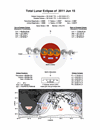- - text and links as of last publication - -
![]()
This first Moon eclipse in 2011 is about a perfect, textbook total lunar, as the Moon, at greatest, is deep and quite middle inside Earth's umbra! This leads to a long eclipse, with the total phase itself at 100 minutes, as the last eclipse to exceed this duration was in July 2000. The whole show will last a long 5h and 26 minute long. Moon, by the eclipse is lying in southern Ophiuchus. The June 15th, 2011 eclipse is seen over Africa, Central Asia and southern Asia. Like said, the conditions of the eclipse makes that Moon is passing about dead center of the Earth shadow, with Moon's center separated of the shadow center by a mere 5.3 arc-minutes! Northern regions of Moon might barely be lighter somewhat by greatest. The Moon's southern limb will lay 34.2 arc-minutes from the edge of the umbra while the northern limb will lay 22.3 arc-minutes from the umbra's edge. A total lunar eclipse if a fine show worth the observation, with Moon progressively occulted and darkened by Earth's 'umbra,' giving a deep sense of the astronomical scales of the Universe and the large events which may occur there. for more about Moon eclipses, theoretically, see our tutorial: Moon Eclipses
The whole of the eclipse is observable from southern and central Africa to Central Asia and eastern Indonesia. Europe, western Africa and most of South America have the eclipse already en cours by moonrise, as China, Japan, Southeast Asia, Australia and New Zealand have the eclipse interrupted by moonset. North and Central America, or a large fraction of the Pacific Ocean do not have any eclipse at all
The eclipse's main data are the following (data as of November 2010). for more about how to observe a lunar eclipse, see our tutorial "Observing a Moon Eclipse":
- umbral magnitude (fraction of Moon's diameter immersed in the umbra at greatest): 1.6998
- greatest eclipse: 20:12:35.8 UT
- eclipse semi-duration (penumbral): 02h 48m 6s
- eclipse semi-duration (umbral): 01h 49m 40s
- total eclipse duration: 1h 40m 13s
- eclipse contacts (in UT): P1 at 17:24:33, U1 at 18:22:55, U2 at 19:22:29, U3 at 21:02:41, U4 at 22:02:14, P4 at 23:00:44
 | see a map of the June 15th, 2010 total lunar eclipse (path of the Moon within the Earth's umbra and map of the visibility of the eclipse worldwide). map courtesy map courtesy Fred Espenak - NASA/GSFC |
By the time of greatest, with Moon lying in Ophiuchus, the summer Milky Way might glow and provide for a fine background for the observation. The summer constellations will be well placed too for viewing so a number of bright stars can be used for magnitude comparisons with the totally eclipsed Moon, Antares (0.96), Shaula (1.63), Epsilon Sgr (1.85), Arcturus (-0.04) or Altair (0.77)
. for more about this eclipse and for more about solar and lunar eclipses generally, you may see at Fred Espenak's NASA's eclipse website
Observation Reports: no special report was made about that eclipse
Website Manager: G. Guichard, site 'Amateur Astronomy,' http://stars5.6te.net. Page Editor: G. Guichard. last edited: 1/1/2011. contact us at ggwebsites@outlook.com